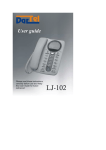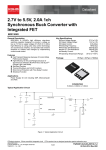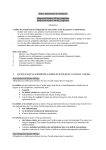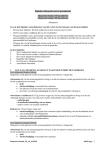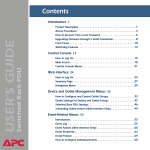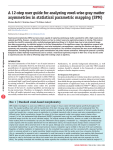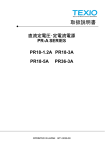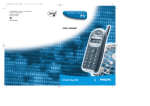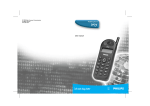Download Dartel LJ-100 User guide
Transcript
User guide Please read these instructions carefully before use and keep this User Guide for future reference! LJ-100 User Guide LJ-100 Please read these instructions carefully before use and keep this User Guide for future reference. 1 Contents LJ-100 Contents I. Introduction......................................................................................... Telephone features............................................................................... Function button index............................................................................ II. Getting started................................................................................... How to connect the batteries................................................................ How to mount the stand…………………………………………………… How to connect the handset and telephone line................................... How to set the dial mode for your type of telephone exchange............ Wall mounting………………………………………………………………. III. Using the telephone......................................................................... How to set the display contrast............................................................. How to set date and time...................................................................... Ringer volume control........................................................................... How to select ringer melody.................................................................. 2-way speaker function......................................................................... How to make a call............................................................................... How to receive a call............................................................................. OUT memory........................................................................................ How to delete the OUT number............................................................ Redial function...................................................................................... Auto-redial function………………………………………………………… How to enter a pause............................................................................ How to set a pause………………………………………………………… Hold function......................................................................................... Memory.......................................................................…………………. Flash function........................................................................................ How to lock telephone numbers............................................................ Alarm function....................................................................................... “Don’t disturb” function.......................................................................... Calculator.............................................................................................. IV. Clip (Caller ID) – Calling line identification presentation............. How to review Clip numbers................................................................. How to delete Clip numbers.................................................................. VIP function.......................................................................................... How to make a call from the Clip memory............................................ How to set the prefix……………………………………………………….. How to set the local area code.............................................................. V. Connecting the headphone……………………………………………. VI. Help................................................................................................... Important advice.................................................................................. 2 3 3 5 7 7 7 8 8 8 9 9 9 10 10 11 12 12 13 13 14 14 14 15 15 16 19 20 20 22 23 24 24 25 25 26 27 27 29 30 31 I. Introduction LJ-100 I. Introduction Important! Please read these instructions carefully before use and keep this User Guide for future reference. Telephone components supplied: ! telephone set (base unit + handset), ! handset cord, ! line cord, ! stand, ! user guide, ! guarantee card. # Telephone features ♦ ♦ ♦ ♦ ♦ ♦ ♦ ♦ ♦ ♦ ♦ ♦ ♦ 12-digits, green backlit LCD display 10 two-touch number memory 7 one-touch number memory Calculator CLIP(Caller ID) – calling line identification presentation in FSK/DTMF European system 100 memory locations telephone number review date and time display local area code enter prefix call back VIP function Alarm-clock Call timer Adjustable display contrast Date and time setting Handset volume rotary switch Last number redial 30 redial number memory Pause 3 I. Introduction LJ-100 ♦ ♦ ♦ ♦ ♦ ♦ ♦ ♦ ♦ ♦ ♦ ♦ 2-way speaker function 2-way speaker volume rotary switch Pre-dial function Flash 16 types of ringer sound selectable (8 melody ringers) Ringer volume control „Don’t disturb” function Music on hold Tone/pulse dialling Lock for long distance calls Headphone socket Wall mounting 4 I. Introduction # LJ-100 Function button index 1. 2. 3. 4. 5. 6. 7. 8. 9. 10. 11. 12. 13. 14. 15. 16. 17. 18. 19. 20. 21. 22. 23. 24. 25. 26. 27. 28. 29. 30. 31. 32. 33. 34. 35. NEW indicator M1...M7 buttons Display DEL/TIME button BRT/SLP button VIP/P button VOLUME HI/LOW rotary switch STORE button RECALL button FLASH button SP-PHONE button RD/ARD button SET/HOLD button Keypad Handset socket Handset volume rotary switch Handset loudspeaker UP/+ button DOWN/- button OUT/x button BACK/÷ ÷ button CAL button DC 9V socket RINGER Hi/Low switch DIAL MODE T/P switch TEL OUT line socket TEL IN line socket Handset hole Handset microphone Handset socket */. button Base microphone #/= button Wall clip Hold clip 5 I. Introduction LJ-100 Note! The line sockets TEL OUT, TEL IN, the RINGER Hi/Low switch, the DIAL MODE T/P switch, the DC9V socket, the handset socket are located on the side of the base unit. In addition, on the bottom of the base unit, is the socket for blocking telephone numbers. 6 II. Getting started LJ-100 II. Getting started # How to connect the batteries ♦ ♦ ♦ Remove the cover of the battery compartment on the underside of the base unit. Fit three 1,5V AA batteries, Replace the battery compartment cover. Note! Instead of batteries, the adaptor to the DC9V socket, which is placed on the side of the base unit can be connected. The parameters of the adaptor must be as follows: ! inside voltage – UIN = 230V, f =50 Hz ! outside voltage– Uout = 9V DC ! current Ioutmin = 100 mA ! standard plug (Φ=2.1 mm) with „-” inside. Adaptor is not in complete! # How to mount the table stand See below picture. 7 II. Getting started # LJ-100 How to connect the handset and telephone line ! ! Plug one end of the coiled handset cord into the handset and the other end into the socket on the side of the telephone. Insert the base unit’s telephone line plugs into the PTT wall socket and telephone socket TEL IN as shown on the illustration. Note! The telephone is equipped with two line sockets. These sockets are connected in parallel. It does not matter, where the telephone line and second telephone are connected. After connecting the telephone, the display shows the date and two clocks. These symbols will be always displayed in the standby mode. # How to set the dial mode for your type of telephone exchange These are two different modes a telephone can use to communicate with the local exchange. Modern telephone exchanges accept TONE dialling, but some older exchanges accept only PULSE dialling. This telephone is capable of either type of dialling- but if your local telephone exchange is a modern one that accepts TONE dialling, this is the best type to use, because: ! it gives you much faster connections, ! it allows you to use special functions if they are available in your area. To set the right dial mode: move the DIAL MODE T/P switch to T or P position. Note! Special functions are available only if the relevant TP S.A. services have been subscribed to. If more information is required, please contact the BOK office or your network provider. # Wall mounting The wall mount brackets are located underneath the telephone base unit. The telephone can be conveniently wall mounted near the PTT line socket. To mount the base onto the wall: ! drill two holes into the wall in the correct position, a distance of 124mm apart. Put the screws into the wall, leaving about 5 mm free to hang the wall mounting bracket, ! set the wall clip in the right position, ! replace the handset on the base unit, ! hang the telephone onto the screws. YOUR TELEPHONE IS NOW READY FOR USE!!! 8 III. Using the telephone LJ-100 III. Using the telephone # How to set the display contrast The setting factory is 3. To set the display contrast: ♦ press the SET/HOLD button, until the display will show the right setting for you. BRT/SLP DEL/TIME ♦ Press the DEL/TIME button to return to the standby mode. If the DEL button is not pressed, the telephone will return to standby mode after several seconds. The setting will be stored. # How to set date and time SET/HOLD 2 ABC GHI 5 JKL PQRS 8 TUV / 0 OPER 1 4 7 3 6 9 DEF MNO WXYZ /= To set date and time: ♦ press the SET/HOLD button. The display will show - 0 1 2 3 4 5 6 7 -. ♦ Press the 1 button. The display will show the symbol 2004 indicating the year. The one before last digit will be flashing. ♦ Use the keypad to enter the right digits. For example, if you want to set the year 2005: ! press the 0 button, the last digit will start to flash, ! then, press the 5 button. ♦ After setting the year, the first digit indicating the month will start to flash. Use the keypad to enter the right digits. For example, if you want to set August: ! press the 0 button, the next digit will start to flash, ! then, press the 8 button. ♦ After setting the month, the first digit indicating the day will start to flash. Use the keypad to enter the right digits. For th example, if you want to set the 27 day of 9 III. Using the telephone 2 ABC GHI 5 JKL PQRS 8 TUV / 0 OPER 1 4 7 3 6 9 DEF MNO WXYZ /= LJ-100 month: ! press the 2 button, the next digit will start to flash, ! press the 7 button. ♦ After setting the day, the first digit indicating the hours will start to flash. Use the keypad to enter the right digits. For example, if you want to set 16.00: ! press the 1 button, the second digit will start to flash, ! press the 6 button. ♦ After setting the hour, the first digit indicating the minutes will start to flash. Use the keypad to enter the right digits. th For example, if you want to set the 59 minute: ! press the 5 button, the last digit will start to flash, ! press the 9 button. After entering the minutes, the telephone will return to standby mode automatically. All settings will be stored. Note! ♦ If incorrect buttons are pressed, the settings will not be confirmed. ♦ During the setting, press the UP/+ or DOWN/- button to move between the digits (to choose the digit, you want to change). # Ringer volume control The volume at which the base unit will ring for an incoming call can be adjusted. To select the volume you prefer: move the RING Hi/Low switch to: ! Low position– low ringing volume or ! Hi position– high ringing volume. # How to select the ringer melody One ringer melody can be selected from among 16 ringer melodies. The settings rING 01-08 indicate the normal ringers and settings rING 09-16 indicate the melody ringers. 10 III. Using the telephone SET/HOLD 2 ABC GHI 5 JKL PQRS 8 TUV / 0 OPER 1 4 7 UP/+ 3 DEF 6 9 MNO WXYZ /= DOWN/- DEL/TIME LJ-100 To select one ringer melody: ♦ press the SET/HOLD button. The display will show - 0 1 2 3 4 5 6 7 -. ♦ Press the 7 button. The display will show an actual setting rING 09. The ringer melody will be played. ♦ Press the UP/+ or DOWN/- button to select the right signal (melody). ♦ Press the SET/HOLD button to confirm the setting. The display will show the symbol - 0 1 2 3 4 5 6 7 – again. ♦ Press the DEL/TIME button. The telephone will return to the standby mode. If the DEL/TIME button is not pressed, the telephone will return to standby mode after several seconds. The setting will be stored. Note! The melody ringers are available only, when the batteries are placed in the battery compartment. If there are no batteries, only the normal ringer will sound. # 2-way speaker function The 2-way speakerphone function allows a number to be dialed, or a call to be made, without the handset needing to be lifted. The party on the other end of the line will automatically be able to hear and to be heard through the speaker located in the base unit of the telephone. When using this function, the user needs to speak within a reasonable distance of the telephone microphone in order that the microphone may pick-up voice sound. This function may also be used to make a conference call between several parties in the same office. Using the SP-PHONE button, the 2-way speakerphone function can be switched on/off. After pressing the SP-PHONE button, the display will show the timer. SP-PHONE In addition, the VOLUME HI/LOW rotary switch can be used to adjust the volume of the loudspeaker. HI VOLUME W LO 11 III. Using the telephone # LJ-100 How to make a call SP-PHONE 2 1 4 7 ABC GHI 5 JKL PQRS 8 TUV / 0 OPER 3 6 9 To make a call: ♦ lift the handset from the base unit or ♦ press the SP-PHONE button. The display will show the timer. ♦ DEF MNO WXYZ /= ♦ SP-PHONE When the PTT on-line signal is heard, the required number should be dialed. The number will be displayed. After several seconds, the call time counter will be switched on. To end your conversation, replace the handset on the base unit or press the SP-PHONE button. The time of your last call can be displayed by pressing the OUT/X button (see the chapter: ”OUT memory”) Note! The telephone number in the standby mode can also be entered (before lifting the handset or pressing the SP-PHONE button).If you wish to delete the last incorrect digit, press the DEL/TIME button. If you wish to make a call, press the BACK÷ button. The 2-way speaker function will be switched on and the number will be dialed automatically. # How to receive a call When the telephone rings: ♦ lift the handset from the base unit or press the SP-PHONE button. In addition, on the side of the handset there is the rotary switch, which can be used to adjust the volume of the handset or the VOLUME HI/LOW rotary switch to adjust the volume of the base’s loudspeaker. SP-PHONE ♦ After completing your conversation, replace the handset on the base unit or press the SP-PHONE button. 12 III. Using the telephone # LJ-100 OUT memory Your telephone can store 30 the most recently dialed numbers in the OUT memory. They can be reviewed by pressing the OUT/X button in standby mode. Each number may consist of up to 16 digits. To review OUT numbers: ♦ press the OUT/X button. The display shows the last number dialed. ♦ Press the OUT/X button again to display the time of this call and the number of the memory location. OUT/x ♦ Press the OUT/X button again. The display shows the number, stored in the lower memory location. ♦ Press the OUT/X button again to display the time of this call and the number of the memory location. ♦ By pressing the OUT/X button, the remaining numbers can be reviewed. If the OUT/X button is not pressed, the telephone will return to standby mode after several seconds. If the memory is empty, the display will show the symbol - - - End - - -. To make a call: ♦ press the OUT/X button to select the number . OUT/x BACK/ SP-PHONE # ♦ Press the BACK/÷ ÷. button. The 2-way speaker function will be switched on and the number will be dialed automatically. ♦ After the call, replace the handset on the base unit or press the SP-PHONE button. How to delete an OUT number OUT/x To delete an individual number: ♦ press the OUT/X button to select the number, to be deleted. 13 III. Using the telephone LJ-100 ♦ DEL/TIME Press the DEL/TIME button twice. The number will be removed. To delete the all numbers: ♦ Press the OUT/X button. ♦ Press and hold the DEL/TIME button until - - - End - - - is displayed. After several seconds, the telephone will return to standby mode. All numbers will be removed. # Last number redial Your telephone automatically stores the last number dialed of up to 32 digits long. This function can be used, when the number is busy. To redial: ♦ lift the handset or press the SP-PHONE button. SP-PHONE ♦ Press the RD/ARD button. The last number will be displayed and dialed. RD/ARD # Autoredial function The Autoredial function allows the last number to be redialed during the using the 2-way speaker button. This operation can be repeated many times, until a connection is made. RD/ARD # To dial the number again: ♦ press the RD/ARD button. The 2-way speaker function will be switched off briefly. After an interval, the 2-way speaker function will be switched on and the number will be dialed again automatically. How to enter a pause With some switchboards, after dialing the access code you may have to wait for a moment while the switchboard picks up an outside line. To compensate for this, you can enter a pause within a phone number. 14 III. Using the telephone LJ-100 SP-PHONE VIP/P 2 ABC GHI 5 JKL PQRS 8 TUV / 0 OPER 1 4 7 3 6 9 DEF To enter a pause: ♦ lift the handset or press the SP-PHONE button. ♦ Enter the access code for an outside line, for example 0. ♦ Press the VIP/P button to enter a pause. The symbol P will be showed on the display. MNO WXYZ /= SP-PHONE ♦ Enter the remaining digits of the telephone number. ♦ After your call, replace the handset on the base unit or press the SP-PHONE button. Note! The number and pause can be also entered in the standby mode. To make a call, press the BACK/÷ ÷ button. # How to set a pause SET/HOLD 2 ABC GHI 5 JKL PQRS 8 TUV / 0 OPER 1 4 7 UP/+ 3 6 9 DEF MNO WXYZ /= ♦ DOWN/- DEL/TIME # To set a pause: ♦ press the SET/HOLD button. The display will show - 0 1 2 3 4 5 6 7 -. ♦ Press the 6 button. The display will show an actual setting PAUSE 3_6. ♦ ♦ Press the UP/+ or DOWN/- button to select the right time of the pause from among the following setting: 1_0, 2_0, 3_0, 3_6. Press the SET/HOLD button. Press the DEL/TIME to return to the standby mode. Hold function The Hold function allows music to be switched on during the conversation. After pressing the HOLD button, the person on the other end of the line 15 III. Using the telephone LJ-100 will automatically be able to hear music. This function may be used, for example, in offices while a client is on hold. SET/HOLD To switch the hold music on: ♦ inform the person on the other end of the line about a music pause. ♦ Press the SET/HOLD button. The display will show Hold. The telephone will start to play music. The NEW indicator will light up. Note! In activating this function using the UP/+ or DOWN/- button, you may select the melody you wish the caller to hear. There are 8 melodies available, from which you can choose. These are indicated by symbols from 01 to 08. SP-PHONE ♦ You can replace the handset on the base. The connection will not be interrupted. The hold music will be heard through the speaker located in the base unit of the telephone. ♦ Lift the handset or press the SP-PHONE button to continue speaking. The Hold function will be switched off. Note! If the handset is not replaced on the base, press the SET/HOLD button again to switch the hold music off. # Memory Your telephone can store 7 telephone numbers in the one-touch memory and 10 telephone numbers in the two-touch memory. The number can then be dialed by pressing one button or two buttons. The one-touch memory locations are located under the buttons indicating M1-M7 and the two-touch memory locations are located under the buttons of the keypad. Each number that is stored can have up to 16 digits. ! One-touch memory To store a number in the memory: ♦ press the STORE button. The display will STORE show INPUt CodE_. 16 III. Using the telephone 2 ABC GHI 5 JKL PQRS 8 TUV / 0 OPER 1 4 7 3 6 9 LJ-100 ♦ DEF MNO Enter the number, to be stored in the memory. The number will be displayed. WXYZ /= Note! The pause can be stored in the memory by pressing VIP/P button. M1 M2 ♦ Press the STORE button a second time. ♦ Now press one of the number buttons (M1-M7). This gives you the code under which your number will be stored. The telephone will return to standby mode. M3 STORE M4 M5 M6 M7 SP-PHONE To dial a number using the memory : ♦ lift the handset or press the SP-PHONE button. ♦ Next press the appropriate code number key. The number will be displayed and dialed. Note! If there is no number under the code number key, the telephone displays symbol NO COdE. ♦ Replace the handset or press the SP-PHONE button to end the call. SP-PHONE Note! 1. Storing a number in the memory automatically deletes any previous number kept under the individual code number you choose. 2. The stored numbers can be reviewed in the standby mode. To display the number from the code number key: ! press the code number key. The number will be displayed. 17 III. Using the telephone ! LJ-100 Two-touch memory STORE 2 ABC GHI 5 JKL PQRS 8 TUV / 0 OPER 1 4 7 3 6 9 To store a number in the memory: ♦ press the STORE button. The display will show INPUt CodE_. ♦ DEF MNO Enter the number, to be stored in the memory. The number will be displayed. WXYZ /= Note! The pause can be stored in the memory by pressing VIP/P button. 2 ABC GHI 5 JKL PQRS 8 TUV / 0 OPER 1 4 7 STORE ♦ Press the STORE button a second time. 3 ♦ Now press one of the number buttons (0-9). This gives you the code under which your number will be stored. The telephone will return to standby mode. 6 9 DEF MNO WXYZ /= SP-PHONE RECALL 2 ABC GHI 5 JKL PQRS 8 TUV / 0 OPER 1 4 7 3 6 9 To dial a number using the memory : ♦ lift the handset or press the SP-PHONE button. ♦ Press the RECALL button. ♦ Next press the appropriate code number key (0-9). The number will be displayed and dialed. DEF MNO WXYZ /= Note! If there is no number under the code number key, the telephone displays symbol NO COdE. ♦ Replace the handset or press the SP-PHONE button to end the call. SP-PHONE 18 III. Using the telephone LJ-100 Note! 1. Storing a number in the memory automatically deletes any previous number kept under the individual code number you choose. 2. The stored numbers can be reviewed in the standby mode. To display the number from the code number key: ! press the RECALL button, ! press the code number key. The number will be displayed. ! How to delete a number from one-touch and two-touch memory DEL/TIME # During the review: ♦ Press the DEL/TIME button twice. The number will be removed. The telephone will return to standby mode. Flash function This allows various switchboard facilities such as call transfer and conference calls to be used. Contact your communications manager or the person responsible for maintaining your switchboard to find out what facilities are available. The telephone allows the following values to be set: 90ms, 120ms, 180ms, 300ms, 600ms and 1000ms SET/HOLD 2 ABC GHI 5 JKL PQRS 8 TUV / 0 OPER 1 4 7 UP/+ 3 6 9 DEF To set the right Flash value: ♦ press the SET/HOLD button. The display will show - 0 1 2 3 4 5 6 7 -. ♦ MNO WXYZ /= DOWN/- ♦ ♦ Press the 2 button. The display will show an actual setting. The factory setting is 600ms. Press the UP/+ or DOWN/- button to select the right value. Press the SET/HOLD button to confirm the setting. ♦ DEL/TIME Press the DEL/TIME button. The telephone will return to standby mode. If the DEL/TIME button is not pressed, the telephone will return to standby mode after several seconds. The setting will be stored. 19 III. Using the telephone LJ-100 How to transfer a call. FLASH 2 ABC GHI 5 JKL PQRS 8 TUV / 0 OPER 1 4 7 3 6 9 To transfer a call from one internal number to another: ♦ press the FLASH button. DEF MNO WXYZ ♦ Enter the number, to which you want to transfer the call. ♦ Replace the handset on the base unit. /= # How to lock the telephone numbers. The telephone can be blocked so that it is impossible to make a call beginning with the digit „0”, for example: a Long Distance or International call, a Party Line call, or, in the case of an office switchboard, where the number „0” facilitates an outside line , it can block an extension number from being used by an unauthorized person. This is an invaluable feature in the prevention of unauthorized calls and the safeguarding of a telephone bill from unauthorized expense. In order to use this feature the key must be placed in the lock located on the underside of the telephone, and then turned to the required position: ! “red dot” position - the telephone can be used to dial all numbers on the keypad including „0”. ! “green dot” position – the telephone can used to block all numbers. ! “yellow dot” position - the telephone has the lock activated and the number „0” cannot be dialed. # Alarm function Your telephone may be used as alarm clock. Up to three different times may be stored simultaneously, using the alarm function. The telephone will emit the alarm signal for 40 seconds. To programme the alarm: 1. press the SET/HOLD button. The display SET/HOLD will show - 0 1 2 3 4 5 6 7 -. 20 III. Using the telephone 2 ABC GHI 5 JKL PQRS 8 TUV / 0 OPER 1 4 7 3 6 9 DEF MNO WXYZ /= SET/HOLD DEL/TIME LJ-100 2. Press the 5 button. The display will show AL 123. 3. Press the 1 button to set the first alarm. The display will show symbol AL 1OFF. Alarm is off. 4. Press the */. button to switch alarm on. The display will show AL 1 12-00. The first digit of the clock will flash. 5. Using the keypad, enter the hour and minute. For example, if you wish to set 15:37, press the following digits 1537. 6. Press the SET/HOLD button. The display will show AL 123. 7. Press the 2 button. The display will show symbol AL 2OFF. 8. Repeat steps 4 and 5 to set the second alarm. 9. Press the SET/HOLD button. The display will show AL 123. 10. Press the 3 button, if you wish to set the third alarm. The display will show AL 3OFF. 11. Repeat steps 4 and 5 to set the third alarm. 12. Press the SET/HOLD button. The display will show AL 123. 13. Press the SET/HOLD button once more to confirm the setting. The display will show – 0 1 2 3 4 5 6 7 -. 14. Press the DEL/TIME button. The telephone will return to the standby mode. If the DEL/TIME button is not pressed, the telephone will return to standby mode after several seconds. The setting will be stored. Note! You do not have to set three alarms . After displaying symbol AL 123, select the alarm, you wish to set. The alarm signal will be played every day. The alarm can be switched off by pressing the DEL/TIME button. 21 III. Using the telephone Note! ! ! LJ-100 The alarm will only function when the batteries are located in the battery compartment or the base unit is connected to a power supply. To switch the alarm off, set the AL 1OFF symbol by pressing the */. button. # „Don’t disturb” function. Your telephone allows the ringer to be switched off. The telephone will not then ring, with the exception of the VIP numbers (see chapter :„VIP function” ). BRT/SLP UP/+ DOWN/- To switch the ringer off: ♦ press and hold the BRT/SLP button, until SLEEP 0-30 is displayed. The ringer is then switched off for 30 minutes. This is a factory setting. ♦ To change the time, press the UP/+ or DOWN/- button. Each time this button is pressed, the setting is changed by about 30 minutes. The maximum time that the ringer may be switched off is 23 hours and 30 minutes. Note! If the UP/+ or DOWN/- button is not pressed within 5 seconds, the setting will be confirmed as the minimum time (30 minutes). SET/HOLD DEL/TIME ♦ Press the SET/HOLD button to confirm the setting. ♦ Press the DEL/TIME button. The telephone returns to the standby mode and the display shows SLEEP and clock. Note! a) If no further buttons are pressed, the telephone will return to standby mode after several seconds. The settings will be stored. b) If you have an activated CLIP service, all numbers will be stored in the memory. c) Remember, that the flashing display also informs of incoming calls. SP-PHONE To switch the „Don’t disturb” function off ♦ lift the handset or press the SP-PHONE button briefly. The telephone will return to the standby mode. 22 III. Using the telephone LJ-100 # Calculator Your telephone may be used as calculator. To switch the calculator on/off press the CAL button. After pressing this button, the display will show the digit 0. Below is a description of all button functions: ♦ the OUT/x button– multiplication, ♦ the BACK/÷ ÷ button- division, ♦ the UP/+ button- addition, ♦ the DOWN/- button- subtraction, ♦ the DEL/TIME button– clearing of data, ♦ the BRT/SLP button- addition and subtraction, ♦ the */. button– adding a decimal point, ♦ the #/= button- result/total. 23 IV. Clip (Caller ID)- Calling line identification presentation LJ-100 IV. Clip (Caller ID)- calling line identification presentation Note! CLIP function is only available if you have subscribed to the relevant TP S.A. services or those of another Provider. If more information is required, please contact the BOK (Customer Service Office) office in your area.. Your telephone displays and stores the number of the caller. The number is displayed until the UP/+ or DOWN/- button is pressed or the handset lifted. The number can be identified using the FSK system In Poland, the FSK system is obligatory. The FSK system is the best to use, because: ! it allows the sending of statements, which define the status of the number, ! it allows the automatic setting of time and date. The telephone can store a maximum of 100 numbers. Together with the number, date, time and statements (symbols) are also stored. The display can show the following symbols: ! NEW- a new number is stored in the memory, ! REP- the number is repeated, ! - - - P - - -- the number is private and cannot be displayed, ! - - - O - - - - the number is unknown and cannot be shown, ! Error (- - - E- - - )- an error has occurred in sending the number. The number is identified and stored in the following form: for example- 0 42 1234567, The identified number consists of: 0- prefix, 42- local area code, 1234567- number of subscriber. Note! If the clip memory is full, storing a new number automatically deletes the first stored number. # How to review Clip numbers If new numbers are stored, the NEW indicator flashes. The number is displayed until the UP/+ or DOWN/- button is pressed or the handset lifted. After displaying new numbers, the NEW symbol disappears from the display. New numbers change their status to old numbers. 24 IV. Clip (Caller ID)- Calling line identification presentation LJ-100 To review all numbers: ! press the UP/+ button, the display will show the number stored in the first memory location. After next pressing the UP/+ button, the display will show date and time. ! Press the DOWN/- button, the display will show the number stored in the last memory location. After next pressing the DOWN/+ button, the display will show date and time. ! Use the UP/+ and DOWN/- buttons to review all numbers Note! If there are no numbers in the memory, after pressing one of the buttons, the display will show - - End - - -. # How to delete Clip numbers ♦ ! UP/+ DOWN/- DEL/TIME To delete an individual number: press the UP/+ or DOWN/- button to select the number you want to remove. ! Press the DEL/TIME button twice. The number will be removed. Using the UP/+, DOWN/- and DEL/TIME buttons the remaining numbers can be removed. ♦ To delete all numbers: ! press the UP/+ or DOWN/- button. Press and hold the DEL/TIME button, until the telephone will show - - - End - - -. After several seconds, the telephone will return to standby mode. All numbers will be deleted. # VIP function VIP function allows important CLIP numbers to be saved from deletion. Every number, which is saved from deletion, will be indicated by the “padlock” symbol. Note! When the „No-disturb” function is used, VIP numbers are treated very specifically. The telephone will ring, when a signal is received from one of these numbers. UP/+ DOWN/- To save a number: ! press the UP/+ or DOWN/- button to select the number to be saved. 25 IV. Clip (Caller ID)- Calling line identification presentation LJ-100 Press the VIP/P button. The display will show the VIP symbol. ! The above steps can be repeated for the next number. If no further buttons are pressed, the telephone will return to standby mode after several seconds. The settings will be stored. To remove the VIP symbol : ! press the UP/+ or DOWN/- button to select the VIP number. ! Press the VIP/P button. The VIP symbol will disappear from the display. The above steps can be repeated for the next number. ! VIP/P UP/+ # DOWN/- How to make a call from Clip memory UP/+ DOWN/- BACK/ To make a call: ♦ press the UP/+ or DOWN/- button to select the number. ♦ Now, press the BACK/÷ ÷. button. The 2-way speaker function will be switched on and the number will be dialed automatically. ♦ Replace the handset or press the SP-PHONE button to end the call. SP-PHONE Special case! It may happen, that the number identified was stored without a prefix, which is necessary to make long distance calls. Your telephone allows a prefix to be added at the beginning of the number automatically. A prefix is added after pressing the BACK÷ button twice. In Poland, the prefix used is 0. UP/+ DOWN/- BACK/ To make a call using a number without a prefix: ♦ press the UP/+ or DOWN/- button to select the number. ♦ Press the BACK/÷ ÷ button twice. The 2-way speaker function will be switched 26 IV. Clip (Caller ID)- Calling line identification presentation SP-PHONE # ♦ LJ-100 on, the prefix will be added and the number will be dialed automatically. Replace the handset or press the SP-PHONE button to end the call. How to set the prefix SET/HOLD 2 ABC GHI 5 JKL PQRS 8 TUV / 0 OPER 1 4 7 3 6 9 DEF MNO WXYZ /= To enter the prefix: ♦ press the SET/HOLD button. The display will show - 0 1 2 3 4 5 6 7 -. ♦ Press the 3 button. The display will show CodE - 12 -. ♦ Press the 2 button. The display will show 0CodE - -. ♦ Using the keypad, enter the prefix. ♦ Press the SET/HOLD button to confirm the setting. The display will show CodE - 12 -. ♦ Press the DEL/TIME button. The telephone will return to standby mode. If no further buttons are pressed, the telephone will return to standby mode after several seconds. The settings will be stored. DEL/TIME To delete the prefix: ♦ press the SET/HOLD button. The display will show - 0 1 2 3 4 5 6 7 -. ♦ Press the 3 button. The display will show CodE - 12 -. ♦ Press the 2 button. The display will show an actual setting. ♦ Press the */. button. The display will show symbol 0CodE - -. ♦ Press the DEL/TIME button. The telephone will return to the standby mode. # How to set the local area code At present, a local area code does not need to be entered to make local calls. This function can only be used to specify local numbers. Entering a local area code in the memory removes it from all numbers, which belong to the same area. 27 IV. Clip (Caller ID)- Calling line identification presentation SET/HOLD 2 ABC GHI 5 JKL PQRS 8 TUV / 0 OPER 1 4 7 3 6 9 DEF MNO WXYZ /= DEL/TIME LJ-100 To enter the local area code: ♦ press the SET/HOLD button. The display will show - 0 1 2 3 4 5 6 7 -. ♦ Press the 4 button. The display will show ArEA - - - - -. ♦ Using the keypad, enter the local area code. ♦ Press the SET/HOLD button to confirm the setting. ♦ Press the DEL/TIME button. The telephone will return to standby mode. If no further buttons are pressed, the telephone will return to standby mode after several seconds. The settings will be stored. To delete the local area code: ♦ press the SET/HOLD button. The display will show - 0 1 2 3 4 5 6 7 -. ♦ Press the 4 button. The display will show an actual setting. ♦ Press the */. button. The display will show symbol ArEA - - - - -. ♦ Press the DEL/TIME button. The telephone will return to the standby mode. 28 V. Connecting the headphone LJ-100 V. Connecting a headphone The telephone is equipped with a socket, which allows a headphone to be connected. 29 VI. Help LJ-100 VI. Help Please read this Troubleshooting Guide in case of difficulty. ♦ No signal in the the handset: ! check that the telephone is connected to the telephone line. ♦ ! ! ♦ ! ! No dial tone: check that the telephone is connected to the telephone line, check that the DIAL MODE T/P switch is in the correct position. In standby mode (when the handset is on the base unit), the display shows nothing: check that batteries are correctly inserted into the battery compartment, the batteries may be dead. ♦ ! The telephone rings quietly: check that the RINGER Hi/Low switch is in the correct position. ♦ Unable to switch on the 2-way speakerphone function: the batteries are dead, no batteries in the battery compartment. ! ♦ ! No CLIP: Clip function is not activated by your Provider. ♦ ! Alarm function does not work: check that there are batteries are in the battery compartment, the batteries may be dead. ! 30 VI. Help # LJ-100 Important advice ♦ ♦ ♦ ♦ ♦ ♦ Never use your telephone during a thunderstorm. Unplug it from the telephone line and the mains socket when there are storms in your area The telephone should not be installed near a sink, bath or shower. Electrical appliances can cause serious injury if the user is wet or standing in water. The telephone should be cleaned only when disconnected from the telephone PTT line. Please clean the telephone with a soft cloth to prevent scratching. Do not use chemical sprays or aerosols to clean the telephone. Do not put the telephone in a wet, damp place or, in bright sunlight or where it could be damaged. 31 Declaration of Conformity (CE) LJ-100 DECLARATION OF CONFORMITY MANUFACTURER'S NAME: Przedsiębiorstwo “DARTEL” ADDRESS: 29-100 Włoszczowa, Podlipie 26 TYPE OF PRODUCT: Corded phone PRODUCT NAME: LJ-100 We inform, our products conform to the requirements of the following Directives and Norms: 1) Radio & Telecom Terminal Equipment Directive 99/5/EEC, 2) Low Voltage Directive 73/23EEC, norm PN-EN 60950 -1, 3) Electromagnetic Compatibility Directive (EMC) 89/336/EEC, norm PN-EN 55022, norm PN-EN 55024, norms PN-EN 61000-4/-2/-3/-4/-5/-6/-8/-9/-11/. In additional, our products fulfill the requirements contained in: 1) norm PN -T - 83001, 2) enclosure no. 18, Communication Minister's decree from 04.09.1997. Date: May 2005 32

































